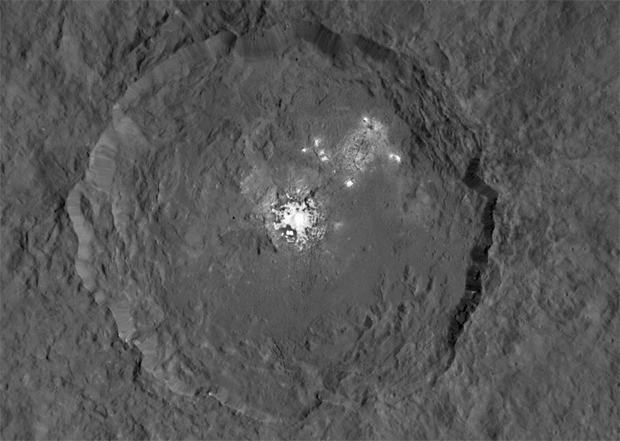Bright spots on dwarf planet Ceres seen in greater detail
Intriguing bright spots in a crater on the dwarf planet Ceres, the largest body in the asteroid belt between Mars and Jupiter, are coming into sharper focus as NASA's Dawn spacecraft studies the world from a 915-mile-high mapping orbit. It will descend to an altitude of just 230 miles or so later this year.
The bright spots were first detected by Dawn's instruments during its approach to Ceres, prompting widespread speculation about possible ice or salt deposits, volcanic eruptions of some sort, icy geysers or impacts that either deposited material of exposed a layer of younger, brighter material below the surface.
The latest images from Dawn reveal surface features as small as 450 feet across. The two bright spots are now resolved into one very bright area near the center of a crater known as Occator with about eight smaller concentrations to one side surrounding an area where the deposits appear more spread out.
Researchers with the Dawn project have not yet weighed in on what the bright material might be or how it got there.
"Although our data are now of higher resolution, we're still missing key pieces of information that we really need to know the whole picture," Carol Raymond, the Dawn deputy principal investigator, told CBS News.
"Essentially, the important information we're missing is the detailed chemistry of these deposits. We won't know that until we complete the spectral mapping and have fully analyzed those data. Then, as we get much closer to the surface, we'll be able to better resolve at the level of these individual deposits and assess whether these bright materials are all the same or are there different flavors of the constituents?"
Dawn arrived at Ceres on March 6 and has been slowly spiraling in to lower and lower altitudes. It reached the intended high-altitude mapping orbit, or HAMO, in early August and in December, the spacecraft is expected to drop down to a low-altitude mapping orbit just 230 miles above the surface of the dwarf planet.
"The surface of Ceres is really an enigma," Raymond said. "It's not like you look at that and say oh yeah, I saw that on the moon or on (Saturn's moon) Dione, so I know what that is. Ceres, as predicted, is a unique body. So it's kind of hard to take some of the initial observations and really understand the bigger picture."
She said Dawn's ever sharper pictures are like "peeling an onion."
"And the thing is, each time you get a layer off ... you're seeing more things that you can't explain. That's really the message here. This is really turning into a journey of discovery on so many levels."As for the bright spots: "We're debating origins quite hotly within the team, and we don't have answers yet," Raymond said.
The Dawn spacecraft is expected to map the entire surface of Ceres six times during its current orbit, allowing researchers to assemble stereo views of surface features and 3D maps. The Planetary Society posted a gallery of 3D images Wednesday.
The Dawn mission is expected to continue through June 2016.


